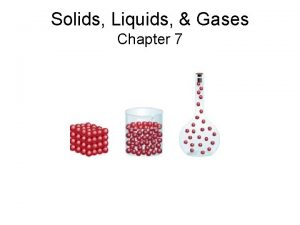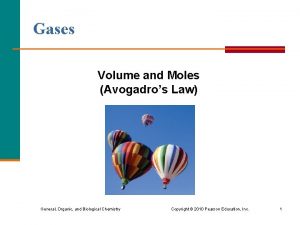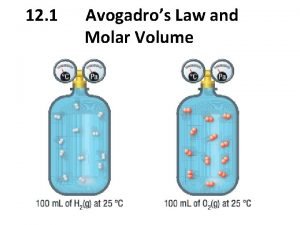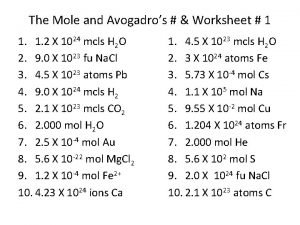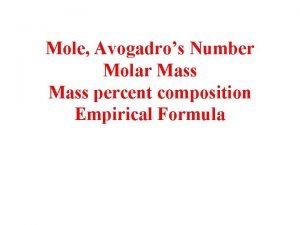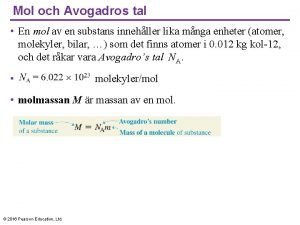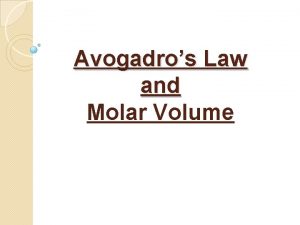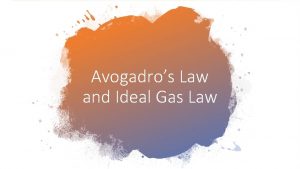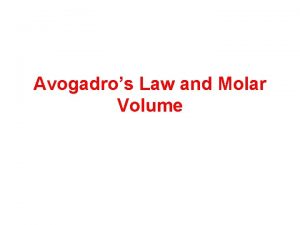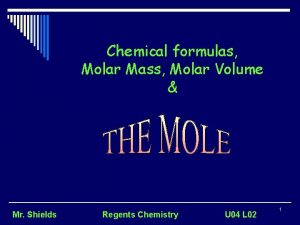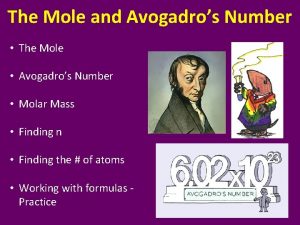12 1 Avogadros Law and Molar Volume The










- Slides: 10

12. 1 Avogadro’s Law and Molar Volume

The Law of Combining Volumes • Water can be decomposed into hydrogen and oxygen using electricity 2 H 2 O(l) 2 H 2(g) + O 2(g) • H 2 O consists of 2 H atoms and 1 O atom. • When water decomposes twice the volume of hydrogen as oxygen is produced

The Law of Combining Volumes • Proposed by Joseph Gay-Lussac • The Law of Combining Volumes: When measured at the same temperature and pressure, volumes of gaseous reactants and products of chemical reactions are always in simple ratios of whole numbers • Example: Combining 1. 0 unit of H 2(g) and Cl 2(g) produces 2. 0 units of HCl(g)

The Law of Combining Volumes • Ammonia gas can be produced by combining nitrogen, N 2(g), and hydrogen, H 2(g) N 2(g) + 3 H 2(g) 2 NH 3(g) Coefficients: Mole Ratio: Volume Ratio: 1 1 1 3 3 3 2 2 2 • While Gay-Lussac Proposed the law, he was unable to explain it

Avogadro’s Law • Avogadro’s law: the volume (V) of a gas is directly related to the amount (n) of the gas when temperature and pressure remain constant V 1/n 1 = V 2/n 2 Where: V is the Volume in L n is the amount in mol

Avogadro’s Law • Explains the law of combing volumes: – Equal volumes of gases, at the same temperature and pressure, contain the same number of molecules. – The mole ratios provided by the balanced equation are also the ratios of volumes – Example: 100 m. L of H 2(g) at 25°C contains the same number of molecules as 100 m. L of O 2(g) at 25°C

Example A balloon with a volume of 34. 5 L is filled with 3. 2 mol of helium gas. To what volume will the balloon expand if another 8. 0 g of helium is added? (Assume that pressure and temperature do not change. )

Molar Volume • Molar Volume: the volume occupied by one mole of a gas. It is the same for all gases. – One mole of any gas at STP (0°C, 101. 3 k. Pa) occupies 22. 4 L – One mole of any gas at SATP (25°C, 100 k. Pa) occupies 24. 8 L

Example 1. A party balloon has 2. 50 mol of helium gas in it at STP. What is the volume of the balloon? (at STP 1 mol = 22. 4 L) 1. A sample of helium at SATP has a mass of 32. 0 g. What volume does this mass of gas occupy? (at SATP 1 mol = 24. 8 L)

Homework Read Section 12. 1 Questions p. 579 #1 -3 p. 580 #1 -3 p. 581 #4
